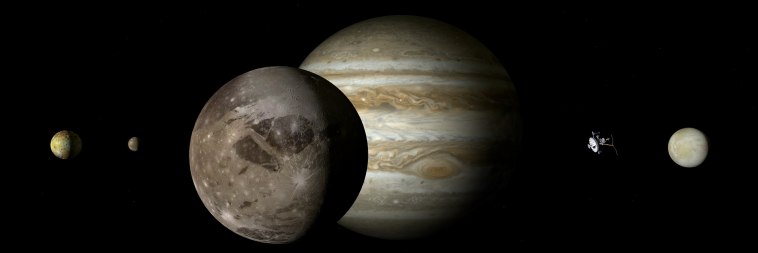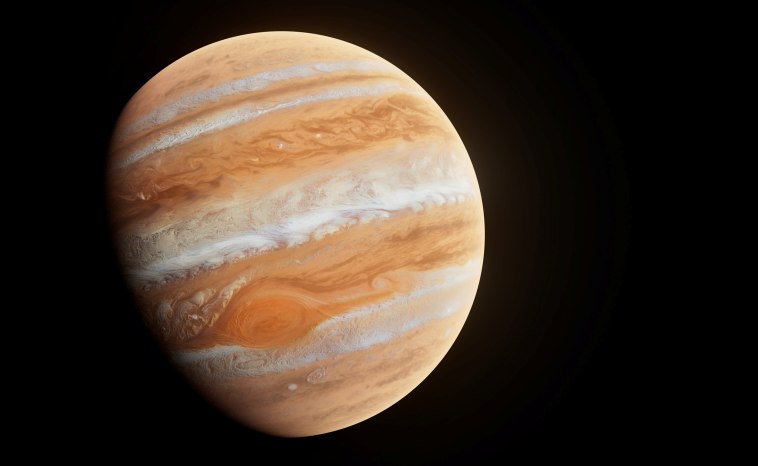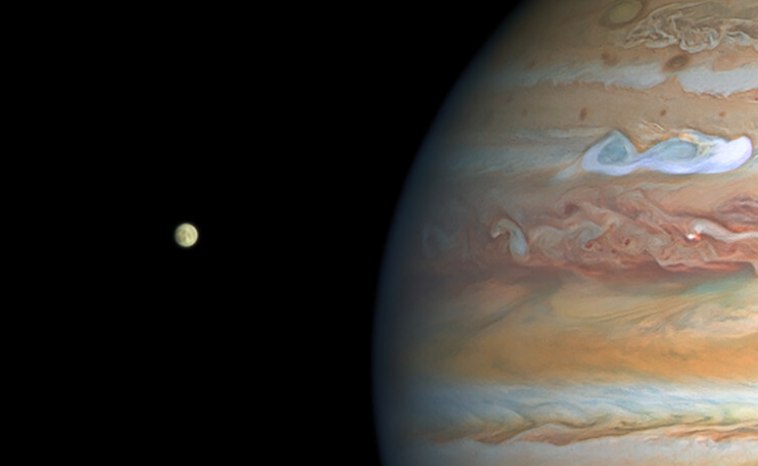Will ESA’s JUICE Mission Find Signs of Life on Jupiter’s Moons?

Later this week, the European Space Agency’s Jupiter Icy Moons Explorer will start its eight-year journey to Jupiter and three of its largest moons. But could JUICE find evidence of past or even present life in the subsurface oceans on Jovian moons? In this article, we’ll tell you everything you need to know.
What Is JUICE?
The Jupiter Icy Moons Explorer – or JUICE – is a new observation mission from the European Space Agency (ESA). First proposed in 2012, JUICE is due to launch on April 13th, 2023. It will depart from the Guiana Space Centre, a European spaceport in French Guiana, a region of France located on the continent of South America.
After reaching the Jovian system, JUICE will aim to make detailed observations of the planet before taking up an orbit around Ganymede, Jupiter’s largest moon. From here, it will observe three of the planet’s so-called Galilean moons – Ganymede, Callisto and Europa.

How Long Will It Take for JUICE To Reach Jupiter?
After leaving Earth, JUICE will begin an eight-year journey to the Jovian system. Along the way, JUICE will take advantage of four gravitational slingshots to amend its trajectory and speed. After flying by Earth and the Moon in 2024, it will swing by Venus in 2025 before making further flybys of Earth in 2026 and 2029. Juice should then arrive at Jupiter in July 2031.
After spending time in orbit around Jupiter, JUICE will perform the first of two Europa flybys before entering orbit around Ganymede in 2034. When it does so, it will make JUICE the first spacecraft to enter orbit around a moon other than Earth’s.
How Long Will the JUICE Mission Last?
Following a year in orbit around Jupiter, JUICE will spend another two years orbiting Ganymede. Beginning with an orbital distance of 5,000 km, in 2035, the spacecraft will enter an orbit just 500 km above Ganymede’s surface.
After using its remaining fuel, JUICE will deorbit and impact Ganymede.
What Will JUICE Study?
JUICE aims to learn more about the conditions of the Jovian moons. Specifically, the mission will try to determine the characteristics of the liquid oceans on the moons of Ganymede, Callisto, and Europa – and how these potentially habitable environments have emerged. JUICE will also spend time extensively studying Jupiter’s atmosphere and magnetosphere.
The mission will devote particular attention to Ganymede, Jupiter’s largest moon and the only moon in our Solar System known to have its own magnetic field. The ESA hopes that the JUICE mission will tell us more about the unique satellite’s role in the Jovian system.

European Space Agency, CC BY 2.0, via Wikimedia Commons
ESA/Hubble, CC BY 4.0, via Wikimedia CommonsWhat Tools Will Juice Use?
When JUICE makes its way to Jupiter, it will carry a payload of ten state-of-the-art instruments to help the mission achieve its goals. Alongside cameras, the spacecraft also possesses an imaging spectrometer to observe cloud features and icy surface characteristics, a spectrograph for studying aurorae and Jupiter’s atmosphere, and an ice-penetrating radar that can examine subsurface environments down to a depth of nine kilometres.
Could There Be Life on Jupiter’s Moons?
There’s a lot that we still don’t know about the Jovian system, but there are some fascinating clues that suggest some of Jupiter’s moons could be habitable. Water is one of the essential elements for life as we know it to exist. Scientists strongly believe that salty liquid water oceans exist under the surfaces of Ganymede, Callisto, and Europa. What’s more, these oceans could be up to 100 km deep. And thanks to tidal flexing caused by the gravitational pull of Jupiter and the orbital exertions the moons have on each other, the temperatures of these oceans would be significantly warmer than on the surface. Furthermore, the thick ice crusts of the moons would protect the subsurface oceans from the worst of the radiation emitted by Jupiter.
By itself, the JUICE mission probably won’t confirm the presence of life in the Jovian system. However, in 2024, NASA will launch the Europa Clipper mission to investigate the possibility of life on the moon. Together, these two missions could change our understanding of the Solar System and maybe answer questions about life beyond Earth.
Fly Me to the Stars
Unfortunately, it will be a long wait until JUICE provides us with any new information. While we wait, why not take a trip through the universe with our Fly Me to the Stars VR app? With just your smartphone and a pair of VR glasses, you can travel the universe, explore planets and constellations, and try to claim rewards in the app’s constellation game.

